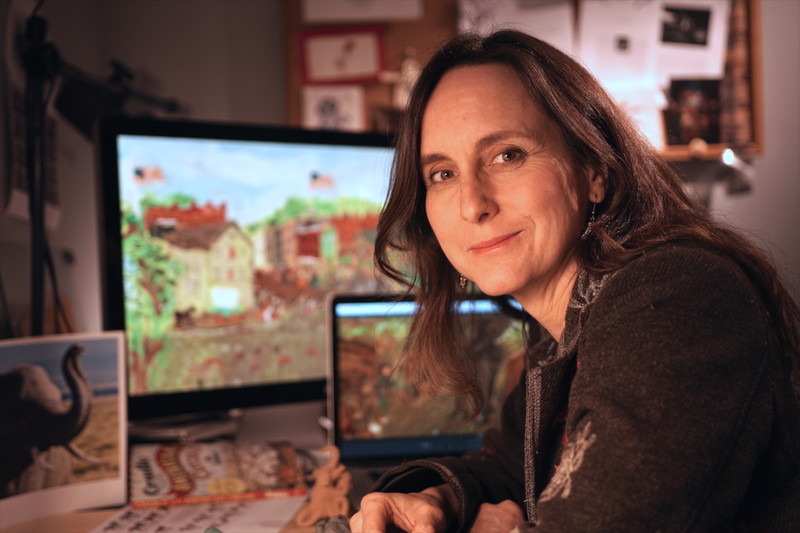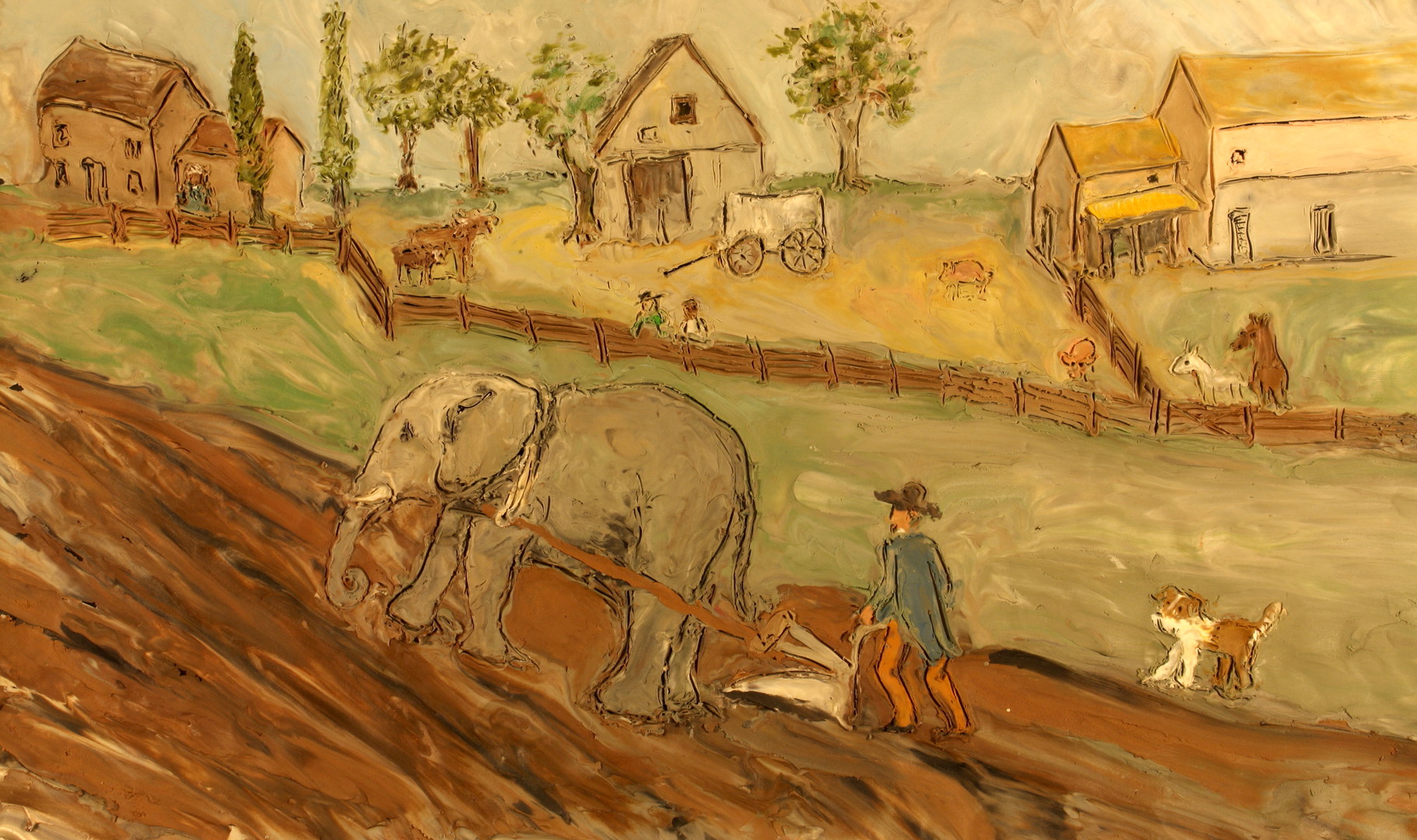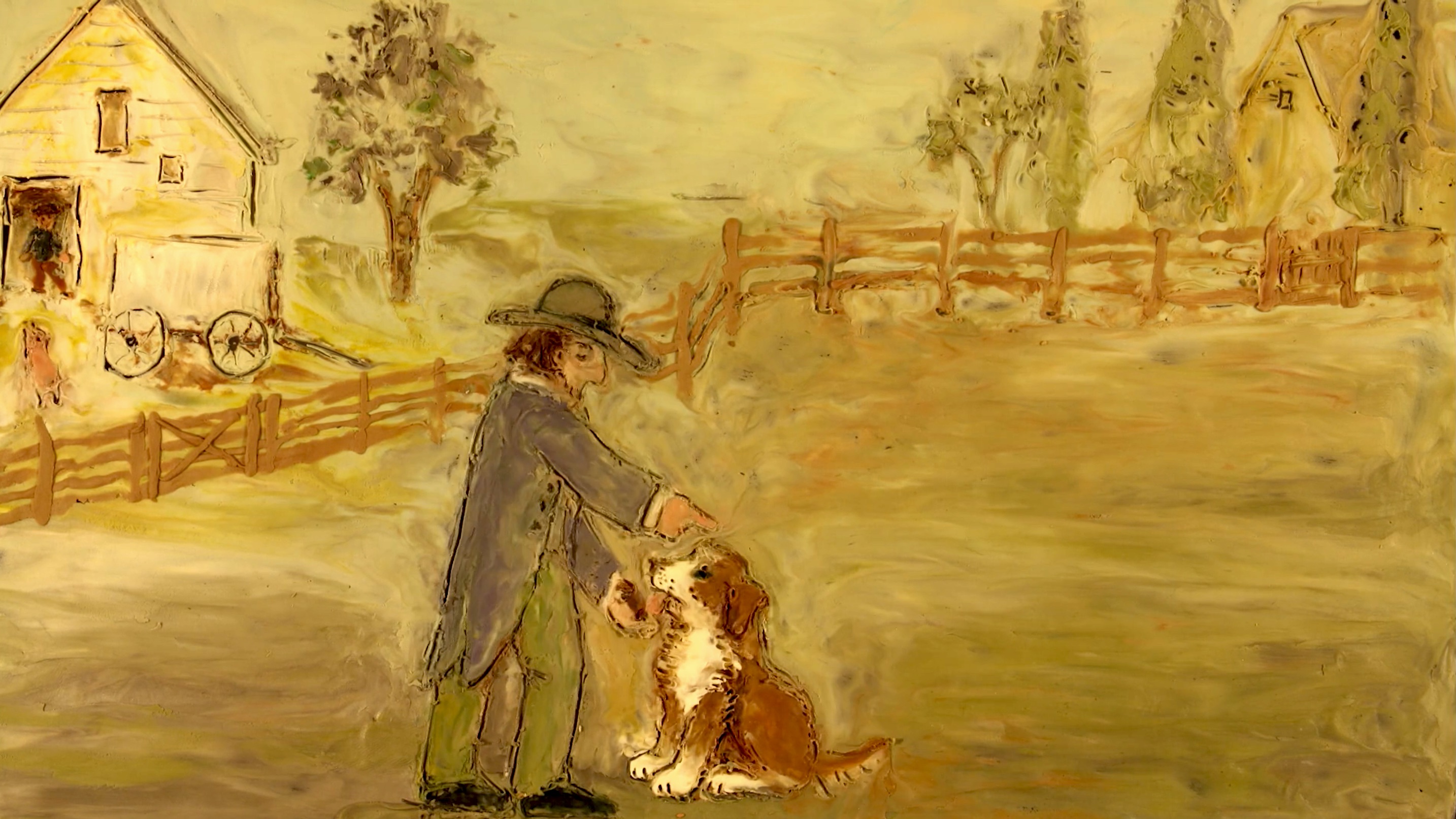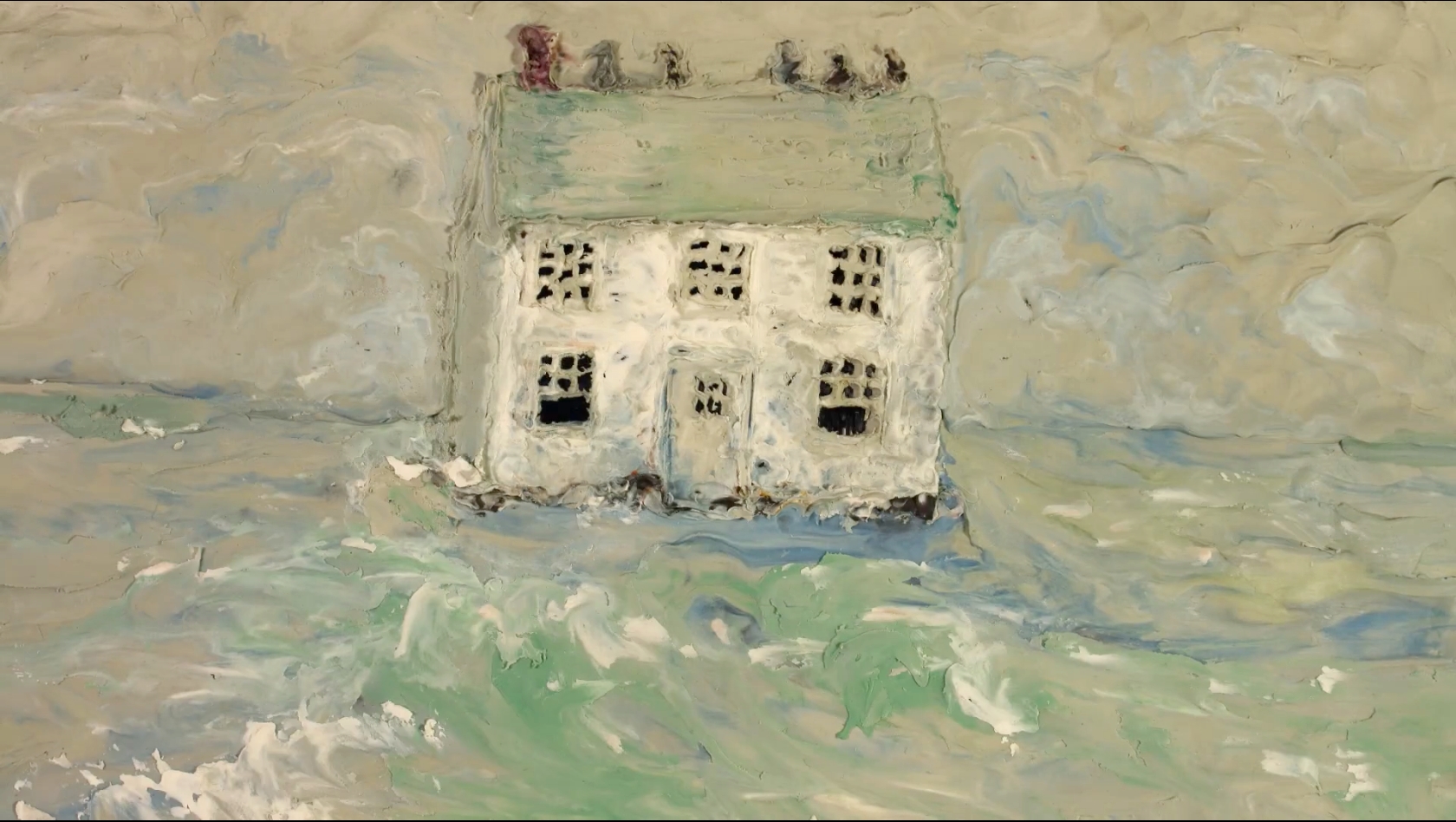A unique voice in animation
Lynn Tomlinson merges music, clay and social consciousness
Exclusive to MeierMovies, August 7, 2018
Maryland artist Lynn Tomlinson has created just two animated shorts in the last five years, but those two films have already cemented her reputation as a unique voice on the film festival circuit.
In 2015, Tomlinson gained attention with The Ballad of Holland Island House. Part documentary, part anthropomorphic allegory, part Irish folk tune, it’s an emotionally involving, stunningly animated tale of a real Chesapeake Bay building slowly succumbing to rising seas and sinking sands. Created by Tomlinson in an Impressionistic, clay-on-glass, stop-motion style – with soulful, narratively rich music – the four-minute masterpiece combines the imagery of Winslow Homer and Vincent Van Gogh with the urgency of climate-change awareness. (Watch it here.)
Tomlinson’s new film is The Elephant’s Song, which is just now building momentum at festivals and picking up awards as it goes. It’s the best and most emotionally resonant animated short film I’ve seen yet in 2018 and, like her previous film, it’s almost entirely self-financed. Song again features Tomlinson’s hand-crafted, clay-on-glass technique, which she first used back in 1989 with I Heard a Fly Buzz When I Died, which was based on an Emily Dickinson poem. But, at just one minute and four minutes, respectively, Fly and Ballad pale in comparison to the complexity of The Elephant’s Song, which is an eight-minute, fully-realized narrative that took roughly a year to create. It’s the tale of the first American circus elephant, Old Bet, who was brought to upstate New York in the early 19th century by Hachaliah Bailey. (Adding to its structural and aesthetic depth, the film departs briefly from clay animation to include rotoscoped pastel drawings.)
 “Thematically, I was interested in a story from a non-human perspective, ‘cause that’s just the challenge I’ve set myself recently,” Tomlinson told me. “Like the house [in The Ballad of Holland Island House] was a non-human perspective, and before that I did a performance piece that … was from the point of view of a jellyfish. So I had a few ideas, but then I [was listening to a] podcast, and I heard an episode about Old Bet, and something about the sort of loneliness appealed to me. And thinking about elephant hide, I thought maybe that would be an interesting thing to do with my clay process. So it was both appealing to me from a thematic perspective and then, as I went into the story, there were so many interesting tangents and such interesting stories connected to the story of this elephant.”
“Thematically, I was interested in a story from a non-human perspective, ‘cause that’s just the challenge I’ve set myself recently,” Tomlinson told me. “Like the house [in The Ballad of Holland Island House] was a non-human perspective, and before that I did a performance piece that … was from the point of view of a jellyfish. So I had a few ideas, but then I [was listening to a] podcast, and I heard an episode about Old Bet, and something about the sort of loneliness appealed to me. And thinking about elephant hide, I thought maybe that would be an interesting thing to do with my clay process. So it was both appealing to me from a thematic perspective and then, as I went into the story, there were so many interesting tangents and such interesting stories connected to the story of this elephant.”
Both Ballad and Song are infused with the sweep of history and a sense of loss. But they approach those themes in slightly different ways. While Ballad is an overtly environmental tale, Song seems more concerned with animal rights. Song might also be seen as a commentary on the slave trade, with the elephant representing the soul of the African people being ripped from their homeland, though Tomlinson cautions that interpreting the film as a direct metaphor for slavery could be distasteful.
“Both [films are] thematically about the changes to the environment and human’s impact on that, and also about impermanence and change, and about kind of the wonderfulness of the past and maybe things that should change and need to change,” she says. “And to me it was important that this was an African elephant. … I was very interested in that because of the connection to the slave trade and the continuation of slavery because of the ivory trade. … I think it’s complicated about whether it serves as a metaphor [to slavery], but the mistreatment of animals is also tied to the mistreatment of humans.”
Unlike live-action filmmaking, animation can often be a lonely business. But Tomlinson offsets that isolation with collaboration. For Ballad, she worked with composer Anna Roberts-Gevalt and singer Elizabeth LaPrelle, and for Song, she partnered with singers Brooks Long and Deletta Gillespie, among many other contributors. But she also worked with someone even more familiar: her son, Sam Saper, who co-wrote the story and song lyrics with his mom, and also composed the music. For Saper, exploring a real subject in unreal ways was irresistible.
“Parts of it are true, right? There’s no talking dog,” Saper reminds us, tongue in cheek, referencing the cartoon mutt who is Old Bet’s best friend and also the film’s singing narrator. “And we don’t necessarily know everything historically, so just like any documentary, it’s on this sort of borderline of what … is truth. It is a shaped narrative that uses real historical reference points, and I think that [it’s] important to sort of tell stories in that kind of way where there are the facts but we also have a clear point of view on those facts.”
Saper stresses that by using the dog, not the elephant, as the narrator, the entire story was enriched.
“[The dog] is torn between these two worlds,” he says. “In some sense, it’s an animal and feels kinship with the elephant, but it’s not a wild animal. … It’s a domesticated animal. It feels a degree of loyalty to the master, and the story is sort of about how that is undercut, how that loyalty is undercut. And that is a much more complicated and rich narrative than just the story of the elephant and the farmer.”
The biggest similarity between Ballad and Song is the music, which drives both stories, though the two films’ tunes are remarkably different in style and mood. While Ballad is set to, well, a ballad – specifically with Irish and folk influences – Song’s song swings with a slightly grittier, more upbeat design, infused with the energy of rhythm and blues, and even soul. Saper describes it as “Americana.”
“This time I wanted a different type of song,” Tomlinson says. “I didn’t really want to animate something exactly the same. … We started off with blues as our ideal. I like the idea of blues because it’s a sad story. But then blues are so repetitive, and I thought I just can’t spare two lines being the same thing.”
“It was almost 13 minutes long as a blues song,” explains Saper. “So it was not gonna work.”
Instead, they looked for inspiration to the lead singer of the Carolina Chocolate Drops, Rhiannon Giddens, and also to the band Punch Brothers.
“Some of [the song] came from me compositionally,” Saper says, “and then a lot of it was the capabilities and the preferences of the band that we were working with, Trucker Talk … who were our arrangers. I basically came with lyrics and music and a chord progression, but the specific notes and also the instruments chosen [were] a collaborative effort.”
Despite her recent surge in festival recognition, animation is not something new to Tomlinson, as she’s been creating it for about 30 years. But education is also close to her heart, as Tomlinson has taught at Philadelphia’s University of the Arts, Maryland Institute College of Art, Delaware College of Art and Design, and Cornell University, and is currently on the faculty of the department of Electronic Media and Film at Towson University.
But whether she’s reaching people one on one in a classroom or through her films, Tomlinson’s artistic creations inspire and provoke her audience.
“I hope they can be conversation starters,” she says.
If you want to join that conversation, visit Tomlinson’s website to find out more about her art. And don’t forget to check out The Elephant’s Song at a festival near you. After its debut in May at the Maryland Film Festival in Baltimore, it screened at the Peekskill Film Festival in New York (where it won the Best of Festival Award) and the Woods Hole Film Festival in Massachusetts. It’s headed next to the Hiroshima International Animation Festival in Hiroshima, Japan, on August 24; the Vaasa Wildlife Festival in Vaasa, Finland, on September 21; and the Chesapeake Film Festival in Easton, Maryland, on October 12. Expect a long festival run in 2019, followed by an online release. And to learn more about the story behind the story, check out the Wikipedia article on Old Bet.
So what’s next for Tomlinson? Not surprisingly, it could be another film with a strong environmental theme: underwater sound or, specifically, human’s sound pollution of the oceans.
“My family are biologists, … and I guess I started out as a biology major before becoming an English major,” she says. “[Environmentalism is] our most pressing and crucial concern right now, and everything is connected to it.”
© 2018 MeierMovies, LLC
Update: In August 2021, after a successful festival run, The Elephant’s Song was released online. Watch it here.


